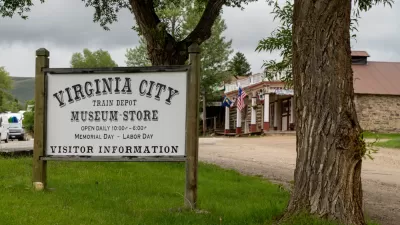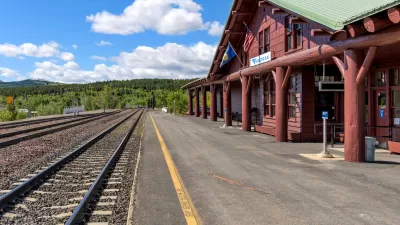As Amtrak gears up to plan expansion projects supported by new federal funding, states can take some advocacy lessons from Maine's popular Downeaster train.

Jake Blumgart describes "one of the most successful state-backed services in America’s passenger rail system" and evaluates how similar efforts could succeed in other states. Maine's Downeaster, which opened in 2001 after a decades-long campaign by the advocacy group TrainRiders Northeast, saw consistent ridership growth before the pandemic—and "[e]ven with ridership still reduced, in October the Downeaster was back to 68 percent of its passenger load of that same month in 2019."
The train has brought significant economic benefits and reduced congestion in communities that previously had little or no access to public transit. "The economic value of the Downeaster can be measured in 100,000 out-of-towners from 'down South' who arrive in the state without clogging the roadways, bringing an estimated $29 million in tourism revenue every year (pre-COVID-19)."
With Amtrak set to receive increased federal funding, advocates say states shouldn't assume they'll be part of expansion plans, but make an assertive case for their rail proposals. As Blumgart writes, "Maine may have been the first state to go to Amtrak with a proposed rail expansion — as opposed to a federal agency courting local lawmakers — but many others have done so since." Jim Mathews, president and CEO of the Rail Passengers Association, warns that launching new train services will be more challenging in today's "vituperative slash-and-burn atmosphere," but the Downeaster offers some useful lessons on how to push train projects forward.
FULL STORY: Maine Loves Its Train. Can Other States Follow in Its Tracks?

Study: Maui’s Plan to Convert Vacation Rentals to Long-Term Housing Could Cause Nearly $1 Billion Economic Loss
The plan would reduce visitor accommodation by 25,% resulting in 1,900 jobs lost.

North Texas Transit Leaders Tout Benefits of TOD for Growing Region
At a summit focused on transit-oriented development, policymakers discussed how North Texas’ expanded light rail system can serve as a tool for economic growth.

Why Should We Subsidize Public Transportation?
Many public transit agencies face financial stress due to rising costs, declining fare revenue, and declining subsidies. Transit advocates must provide a strong business case for increasing public transit funding.

How to Make US Trains Faster
Changes to boarding platforms and a switch to electric trains could improve U.S. passenger rail service without the added cost of high-speed rail.

Columbia’s Revitalized ‘Loop’ Is a Hub for Local Entrepreneurs
A focus on small businesses is helping a commercial corridor in Columbia, Missouri thrive.

Invasive Insect Threatens Minnesota’s Ash Forests
The Emerald Ash Borer is a rapidly spreading invasive pest threatening Minnesota’s ash trees, and homeowners are encouraged to plant diverse replacement species, avoid moving ash firewood, and monitor for signs of infestation.
Urban Design for Planners 1: Software Tools
This six-course series explores essential urban design concepts using open source software and equips planners with the tools they need to participate fully in the urban design process.
Planning for Universal Design
Learn the tools for implementing Universal Design in planning regulations.
Ascent Environmental
Borough of Carlisle
Institute for Housing and Urban Development Studies (IHS)
City of Grandview
Harvard GSD Executive Education
Toledo-Lucas County Plan Commissions
Salt Lake City
NYU Wagner Graduate School of Public Service





























